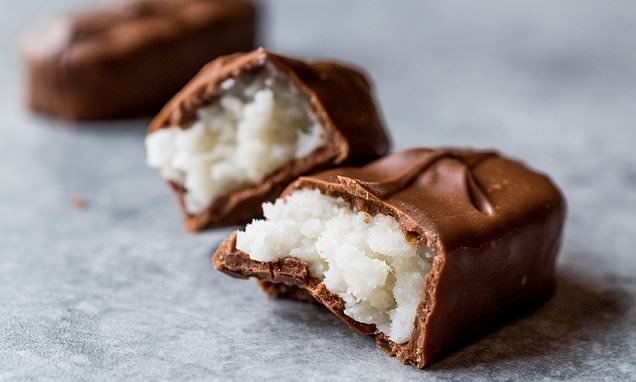Childhood obesity campaigners call for a sugar tax on chocolate, sweets and cereals as Government misses key target to cut sugar out of snacks
- Ministers called on food manufacturers to cut sugar by 20 per cent by 2020
- It was criticised for being voluntary, with no measures forcing industry to act
- Now a new report reveals companies have fallen well short of the reduction
A target to cut sugar in children’s snacks and meals has been missed by the food industry, in an ‘abject failure’ to tackle child obesity.
The Government’s controversial Childhood Obesity Plan called on companies to cut sugar in products such as breakfast cereals, cakes and yoghurts by 20 per cent by 2020.
The programme was fiercely criticised for being voluntary, with no measures forcing the food industry to act.
Now a new report reveals companies have fallen well short of the 20 per cent sugar reduction – managing only 3.5 per cent by 2020.

The Government’s controversial Childhood Obesity Plan called on companies to cut sugar in products such as breakfast cereals, cakes and yoghurts by 20 per cent by 2020
In response, campaigners are calling for a ‘sugar tax’ on snack foods like chocolate bars and sweets.
Graham MacGregor, professor of cardiovascular medicine at Queen Mary University of London and chairman of campaign group Action on Sugar and Action on Salt, said requesting voluntary action from the food industry, to cut people’s sugar intake by reducing packet sizes, changing recipes or promoting low-sugar products, ‘simply does not work’.
WHAT IS THE SUGAR TAX?
From April 2018, soft drinks companies have been required to pay a levy on drinks with added sugar.
If a drink contains between 5g and 8g of sugar per 100ml the tax is 18p per litre, whereas if a drink has more than 8g of sugar per 100ml, the tax is 24p.
Fruit juices and milk are not included in the tax.
The move aims to help tackle childhood obesity. Sugar-sweetened soft drinks are now the single biggest source of dietary sugar for children and teenagers.
Some drinks, including Fanta, Lucozade, Sprite, Dr Pepper and Vimto, had their recipes changed so they contained less than 5g of sugar and the price did not need to be put up.
However, others like Coca Cola and Pepsi refused to reduce the amount of sugar and, as a result, the price of them increased.
The Government has predicted the levy will raise £240million a year, which will be spent on sports clubs and breakfast clubs in schools.
The sugar tax raised £153.8m in the first six months after it was introduced, between April and October 2018.
He said: ‘The UK faces an obesity crisis and one of the principle plans outlined by the Department of Health and Public Health England was to tackle this by reducing sugar in food products by 20 per cent by 2020 across the main food categories.
‘Not surprisingly the plan was an abject failure due to a lack of enforcement.
‘The Government must commit to measures such as mandatory targets for calories, sugar and salt reduction, enforced marketing and promotions restrictions and clearer, mandatory food labelling.’
While the 2020 target was aimed at childhood obesity, the failure to cut sugar will also affect adults, who eat the same foods.
The 3.5 per cent sugar reduction between 2015 and 2020, which falls short of the 20 per cent target, is for the average total sugar content per 100 grams of products sold by supermarkets and shops.
While higher sugar reductions were achieved for yoghurts and breakfast cereals, there have been far smaller sugar reductions in snacks popular with young children, with sugar reduced in biscuits by only around three per cent, in sweets by 2.8 per cent, and in chocolate by less than one per cent.
All the percentages, for foods which contribute most to the sugar intake of children, take into account sales, reflecting that people get more sugar from products when they buy more of them.
Families taking their children out to eat in restaurants and cafes can expect little change in the products on offer.
Overall, for popular children’s foods eaten outside the home, there has been absolutely no change in the average sugar content, which was 25.7 grams per 100 grams of food in both 2017 and 2020.
However the delayed sugar reduction report, which was due to be published last year, showed that the Soft Drinks Industry Levy- a tax on sugary drinks introduced in 2018 – has had a significant effect.
For products subject to the tax, average sugar was down 46 per cent from 2015, taking into account sales.
In response to the new report, published by the Office for Health Improvement & Disparities, Katharine Jenner, director of the Obesity Health Alliance, said: ‘The tax on soft drinks has been an enormous success – reducing sugar intake without leading to a decline in sales.
‘The failure of voluntary measures now show the Government must explore a similar tax on high-sugar foods, which could include some chocolate bars and breakfast cereals.’
WHAT SHOULD A BALANCED DIET LOOK LIKE?

Meals should be based on potatoes, bread, rice, pasta or other starchy carbohydrates, ideally wholegrain, according to the NHS
• Eat at least 5 portions of a variety of fruit and vegetables every day. All fresh, frozen, dried and canned fruit and vegetables count
• Base meals on potatoes, bread, rice, pasta or other starchy carbohydrates, ideally wholegrain
• 30 grams of fibre a day: This is the same as eating all of the following: 5 portions of fruit and vegetables, 2 whole-wheat cereal biscuits, 2 thick slices of wholemeal bread and large baked potato with the skin on
• Have some dairy or dairy alternatives (such as soya drinks) choosing lower fat and lower sugar options
• Eat some beans, pulses, fish, eggs, meat and other proteins (including 2 portions of fish every week, one of which should be oily)
• Choose unsaturated oils and spreads and consuming in small amounts
• Drink 6-8 cups/glasses of water a day
• Adults should have less than 6g of salt and 20g of saturated fat for women or 30g for men a day
Source: NHS Eatwell Guide
Source: Read Full Article
